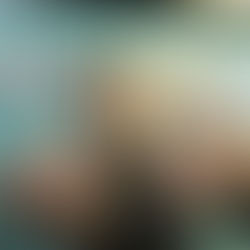An Invitation to Tea [Desiree Abeyta, USA, 2020]
Desiree Abeyta's An Invitation to Tea is a fairytale for the modern age. Accordingly, its protagonist is suffering from the millennial complex par excellence – a fraught relationship to what it means to grow up.

We join the story as a young woman travels to the townhouse of her recently deceased grandfather, who was an author of children's stories, to retrieve his possessions. Although stricken by loss and the disappointments of adult life, the protagonist finds the house is still very much alive with the magic of her childhood memories. Although guarding against an inner fragility with a tough, 'realist' facade, through the arc of the film we see this disenchanted urban woman finally confront her inner child.
Her grandfather's stories had centred around a secret world known as the Land of the Misfits, yet throughout her life, the protagonist has had to reckon with the incompatibility of these ideals with the world she lives in. In ripped jeans, drinking red wine out of a tumbler, the protagonist sees herself as a rebel and an outsider from the tyranny of the adult world, yet cannot help but be knocked down by her inability to face its challenges. Her inner conflict plays out in a magical encounter with one of her grandfather's characters, and as she tries to argue against the 'bullshit ideology' of a talking cat, Abeyta stages a smart critique of a nihilistic modern world in which everything is politics, exposing its unforgiving attitude to innocence and play.

Abeyta's production is highly polished, with impressive costume and prosthetics, clever staging, and lighting that shrouds her world in a purplish veil of magic and nostalgia. Indeed, the film reminds us of cinema's privileged relationship to fantasy. Like the grandfather's home for Abeyta's protagonist, the movie theatre is a place the cinephile can go to experience a kind of re-enchantment, which is sometimes enough to renew the dreams and ideals that have been left to wilt in the real world. In this way Abeyta's film will leave many feeling spiritually charged.
However, the film's somewhat predictable aesthetic decisions, while adept to sweep us off our feet, is at odds with its advice to its viewers to get in touch with their inner Misfit. Abeyta has given us a cinema of the Misfits - but where are the misfits of cinema? Dwelling further on the darkness and ambivalence of childhood experiences may have enriched the film and complicated its binaries between childhood and adulthood, and between reality and fantasy, presenting ways of living which can integrate both.

.png)




![SHORT FOCUS 2022: So What Did We Learn Today, Georgina? [Franco Volpi, UK, 2022]](https://static.wixstatic.com/media/9b7dde_f048f3b1e32c48918d83c1285916aa3c~mv2.png/v1/fill/w_220,h_123,fp_0.50_0.50,q_95,enc_auto/9b7dde_f048f3b1e32c48918d83c1285916aa3c~mv2.webp)

![Two Knights [Piotr Szkopiak, UK, 2022]](https://static.wixstatic.com/media/9b7dde_4b197f184db54afc95f775fe48320bd7~mv2.jpeg/v1/fill/w_220,h_123,fp_0.50_0.50,q_90,enc_auto/9b7dde_4b197f184db54afc95f775fe48320bd7~mv2.webp)
![SHORT FOCUS 2022: Throw Your Heart Over First [Mark McAuley, Ireland, 2021]](https://static.wixstatic.com/media/9b7dde_f17e64582f494d729a117bddc19545a9~mv2.png/v1/fill/w_220,h_123,fp_0.50_0.50,q_95,enc_auto/9b7dde_f17e64582f494d729a117bddc19545a9~mv2.webp)

![Borrowed Time [Ginevra Gentili, UK, 2022]](https://static.wixstatic.com/media/9b7dde_ed0c27adf0984653a11c5104f74a1b58~mv2.jpeg/v1/fill/w_220,h_123,fp_0.50_0.50,q_90,enc_auto/9b7dde_ed0c27adf0984653a11c5104f74a1b58~mv2.webp)

![SHORT FOCUS 2021: Cornflakes Are Rubbish [Charlotte Nind/Jacob Bacon, UK, 2021]](https://static.wixstatic.com/media/9b7dde_800e4f3cde6147399b1eee00f4337095~mv2.jpeg/v1/fill/w_220,h_123,fp_0.50_0.50,q_90,enc_auto/9b7dde_800e4f3cde6147399b1eee00f4337095~mv2.webp)

![SHORT FOCUS 2021: Original Sin [Paolo Sinigaglia, Italy, 2020]](https://static.wixstatic.com/media/9b7dde_ca789cc5313b4f94bf20f025dc4796ee~mv2.jpg/v1/fill/w_220,h_123,fp_0.50_0.50,q_90,enc_auto/9b7dde_ca789cc5313b4f94bf20f025dc4796ee~mv2.webp)

![SHORT FOCUS 2021: Shallow [Paul Ashton, UK, 2021]](https://static.wixstatic.com/media/9b7dde_951699be78e74888bc681fcd9d6c24cc~mv2.jpg/v1/fill/w_220,h_123,fp_0.50_0.50,q_90,enc_auto/9b7dde_951699be78e74888bc681fcd9d6c24cc~mv2.webp)

![SHORT FOCUS 2021: Bohemia [Samuel Kaperski, France, 2019]](https://static.wixstatic.com/media/9b7dde_d748c63a3c814cb99859c13d18c00d7d~mv2.jpg/v1/fill/w_220,h_123,fp_0.50_0.50,q_90,enc_auto/9b7dde_d748c63a3c814cb99859c13d18c00d7d~mv2.webp)


![SHORT FOCUS 2022: So What Did We Learn Today, Georgina? [Franco Volpi, UK, 2022]](https://static.wixstatic.com/media/9b7dde_f048f3b1e32c48918d83c1285916aa3c~mv2.png/v1/fill/w_51,h_39,fp_0.50_0.50,q_95,enc_auto/9b7dde_f048f3b1e32c48918d83c1285916aa3c~mv2.webp)

![In the Eyes of a Child [Marco Ferrara, Italy, 2023]](https://static.wixstatic.com/media/9b7dde_01e294bd769e4a8aa341551ca7bc7871~mv2.jpeg/v1/fill/w_51,h_39,fp_0.50_0.50,q_90,enc_auto/9b7dde_01e294bd769e4a8aa341551ca7bc7871~mv2.webp)
![Two Knights [Piotr Szkopiak, UK, 2022]](https://static.wixstatic.com/media/9b7dde_4b197f184db54afc95f775fe48320bd7~mv2.jpeg/v1/fill/w_51,h_39,fp_0.50_0.50,q_90,enc_auto/9b7dde_4b197f184db54afc95f775fe48320bd7~mv2.webp)
![SHORT FOCUS 2022: Throw Your Heart Over First [Mark McAuley, Ireland, 2021]](https://static.wixstatic.com/media/9b7dde_f17e64582f494d729a117bddc19545a9~mv2.png/v1/fill/w_51,h_39,fp_0.50_0.50,q_95,enc_auto/9b7dde_f17e64582f494d729a117bddc19545a9~mv2.webp)

![The Story of a Trout [Gareth Leah, USA, 2022]](https://static.wixstatic.com/media/9b7dde_044565b04f7b4b6da729f134c619e377~mv2.jpeg/v1/fill/w_51,h_39,fp_0.50_0.50,q_90,enc_auto/9b7dde_044565b04f7b4b6da729f134c619e377~mv2.webp)

![My Name is Moe [Kabir McNeely, USA, 2022]](https://static.wixstatic.com/media/9b7dde_680ffd6c85f642a6844b8785364c4288~mv2.jpg/v1/fill/w_51,h_39,fp_0.50_0.50,q_90,enc_auto/9b7dde_680ffd6c85f642a6844b8785364c4288~mv2.webp)
![Borrowed Time [Ginevra Gentili, UK, 2022]](https://static.wixstatic.com/media/9b7dde_ed0c27adf0984653a11c5104f74a1b58~mv2.jpeg/v1/fill/w_51,h_39,fp_0.50_0.50,q_90,enc_auto/9b7dde_ed0c27adf0984653a11c5104f74a1b58~mv2.webp)
![SHORT FOCUS 2021: Cornflakes Are Rubbish [Charlotte Nind/Jacob Bacon, UK, 2021]](https://static.wixstatic.com/media/9b7dde_800e4f3cde6147399b1eee00f4337095~mv2.jpeg/v1/fill/w_51,h_39,fp_0.50_0.50,q_90,enc_auto/9b7dde_800e4f3cde6147399b1eee00f4337095~mv2.webp)

![The Skin She Sheds [Cass Virdee, UK, 2022]](https://static.wixstatic.com/media/9b7dde_bddd09258c164b9a90431ffd228c378a~mv2.jpeg/v1/fill/w_51,h_39,fp_0.50_0.50,q_90,enc_auto/9b7dde_bddd09258c164b9a90431ffd228c378a~mv2.webp)
![SHORT FOCUS 2021: Original Sin [Paolo Sinigaglia, Italy, 2020]](https://static.wixstatic.com/media/9b7dde_ca789cc5313b4f94bf20f025dc4796ee~mv2.jpg/v1/fill/w_51,h_39,fp_0.50_0.50,q_90,enc_auto/9b7dde_ca789cc5313b4f94bf20f025dc4796ee~mv2.webp)
![SHORT FOCUS 2021: Shallow [Paul Ashton, UK, 2021]](https://static.wixstatic.com/media/9b7dde_951699be78e74888bc681fcd9d6c24cc~mv2.jpg/v1/fill/w_51,h_39,fp_0.50_0.50,q_90,enc_auto/9b7dde_951699be78e74888bc681fcd9d6c24cc~mv2.webp)
![SHORT FOCUS 2021: Bohemia [Samuel Kaperski, France, 2019]](https://static.wixstatic.com/media/9b7dde_d748c63a3c814cb99859c13d18c00d7d~mv2.jpg/v1/fill/w_51,h_39,fp_0.50_0.50,q_90,enc_auto/9b7dde_d748c63a3c814cb99859c13d18c00d7d~mv2.webp)

![SHORT FOCUS 2021: Yuluu [Fatima Kried, UK, 2021]](https://static.wixstatic.com/media/9b7dde_eb393025c61143cf98b6e551df4adf77~mv2.jpg/v1/fill/w_51,h_39,fp_0.50_0.50,q_90,enc_auto/9b7dde_eb393025c61143cf98b6e551df4adf77~mv2.webp)